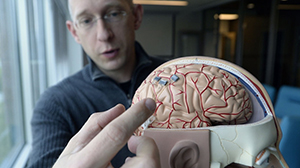
From The Salt Lake Tribune
When Nathan Copeland met then-President Barack Obama last year they exchanged a fist-bump that was far from the ordinary fist-bump.
Copeland has been paralyzed from the chest down for more than a decade, the result of a car accident when he was a teenager. But a device — pioneered in Utah — was able to read his thoughts and tell a prosthetic arm to make a fist and bump knuckles with the president. What’s more, he got “touch” feedback from the mechanical limb — Obama’s hands were warm.
Now the scientists who have been refining and improving the technology want to go further: They want a paralyzed patient to drive a car using only his or her mind.
It’s being called The Speed Project. Florian Solzbacher, a co-founder of Blackrock Microsystems, said the goal is to show a mass audience that it’s science is pushing the medical frontier into new territory.
“There are people we can help today, we know that, so let’s go out and create something where vast parts of the population get it, where it becomes emotional,” he said.
The device they’re implanting, the Utah Electrode Array, is a chip, about a half-centimeter square with a hundred tiny little spires, each tipped with a sensor. It is implanted on the surface of the brain and monitors neural signals, transmitting massive amounts of data to a receiver that uses algorithms to filter out the background noise and translate the patient’s thoughts into action.
The Utah Array was developed in the late 1990s by Richard Normann, a University of Utah professor, and later spun off into Blackrock Microsystems, headquartered at the nearby Research Park.
“If all this Speed Project does, even if it doesn’t prove there’s a billion-dollar market, if it proves we can have a solution for a thousand [paralysis] patients or Locked-in [syndrome] patients, guys who lie there, hear everything, often feel everything but cannot respond, just imagine,” said Blackrock CEO Marcus Gerhardt.
For the full story visit the The Salt Lake Tribune